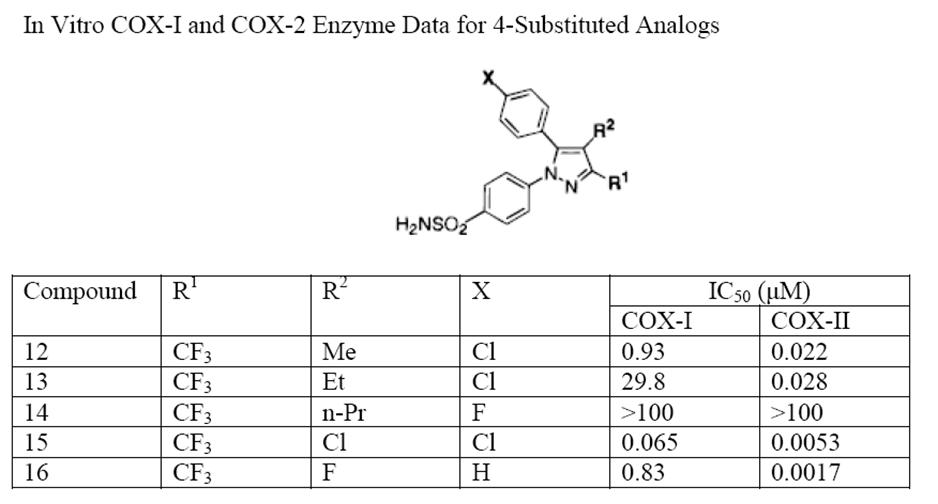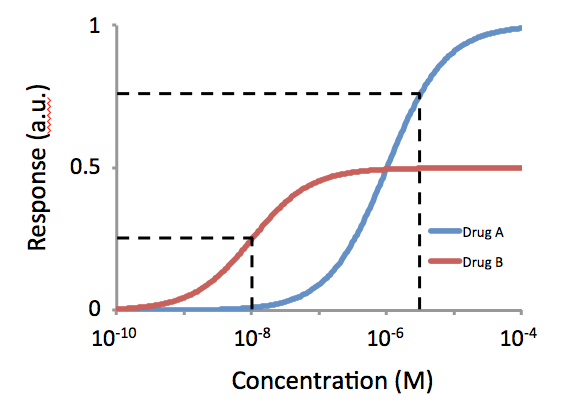|
Discovery And Development Of Cyclooxygenase 2 Inhibitors
Cyclooxygenases are enzymes that take part in a complex biosynthetic cascade that results in the conversion of polyunsaturated fatty acids to prostaglandins and thromboxane(s). Their main role is to catalyze the transformation of arachidonic acid into the intermediate prostaglandin H2, which is the precursor of a variety of prostanoids with diverse and potent biological actions. Cyclooxygenases have two main isoforms that are called COX-1 and COX-2 (as well as a COX-3). COX-1 is responsible for the synthesis of prostaglandin and thromboxane in many types of cells, including the gastro-intestinal tract and blood platelets. COX-2 plays a major role in prostaglandin biosynthesis in inflammatory cells and in the central nervous system. Prostaglandin synthesis in these sites is a key factor in the development of inflammation and hyperalgesia. COX-2 inhibitors have analgesic and anti-inflammatory activity by blocking the transformation of arachidonic acid into prostaglandin H2 selectively. ... [...More Info...] [...Related Items...] OR: [Wikipedia] [Google] [Baidu] |
Cyclooxygenase
Cyclooxygenase (COX), officially known as prostaglandin-endoperoxide synthase (PTGS), is an enzyme (specifically, a family of isozymes, ) that is responsible for biosynthesis of prostanoids, including thromboxane and prostaglandins such as prostacyclin, from arachidonic acid. A member of the animal-type heme peroxidase family, it is also known as prostaglandin G/H synthase. The specific reaction catalyzed is the conversion from arachidonic acid to prostaglandin H2 via a short-living prostaglandin G2 intermediate. Pharmaceutical inhibition of COX can provide relief from the symptoms of inflammation and pain. Nonsteroidal anti-inflammatory drugs (NSAIDs), such as aspirin and ibuprofen, exert their effects through inhibition of COX. Those that are specific to the COX-2 isozyme are called COX-2 inhibitors. The active metabolite ( AM404) of paracetamol is a COX inhibitor, a fact to which some or all of its therapeutic effect has been attributed. In medicine, the ... [...More Info...] [...Related Items...] OR: [Wikipedia] [Google] [Baidu] |
Celecoxib
Celecoxib, sold under the brand name Celebrex among others, is a COX-2 inhibitor and nonsteroidal anti-inflammatory drug (NSAID). It is used to treat the pain and inflammation in osteoarthritis, acute pain in adults, rheumatoid arthritis, psoriatic arthritis, ankylosing spondylitis, painful menstruation, and juvenile rheumatoid arthritis. It may also be used to decrease the risk of colorectal adenomas in people with familial adenomatous polyposis. It is taken by mouth. Benefits are typically seen within an hour. Common side effects include abdominal pain, nausea, and diarrhea. Serious side effects may include heart attacks, strokes, gastrointestinal perforation, gastrointestinal bleeding, kidney failure, and anaphylaxis. Use is not recommended in people at high risk for heart disease. The risks are similar to other NSAIDs, such as ibuprofen and naproxen. Use in the later part of pregnancy or during breastfeeding is not recommended. Celecoxib has demonstrated adjunctive bene ... [...More Info...] [...Related Items...] OR: [Wikipedia] [Google] [Baidu] |
Indometacin
Indometacin, also known as indomethacin, is a nonsteroidal anti-inflammatory drug (NSAID) commonly used as a prescription medication to reduce fever, pain, stiffness, and swelling from inflammation. It works by inhibiting the production of prostaglandins, endogenous signaling molecules known to cause these symptoms. It does this by inhibiting cyclooxygenase, an enzyme that catalyzes the production of prostaglandins. It was patented in 1961 and approved for medical use in 1963. It is on the World Health Organization's List of Essential Medicines. In 2022, it was the 256th most commonly prescribed medication in the United States, with more than 1million prescriptions. Medical uses As an NSAID, indometacin is an analgesic, anti-inflammatory, and antipyretic. Clinical indications for indometacin include: Joint diseases *rheumatoid arthritis * ankylosing spondylitis *osteoarthritis * gouty arthritis *acute painful shoulder bursitis or tendinitis Headaches * Trigeminal auton ... [...More Info...] [...Related Items...] OR: [Wikipedia] [Google] [Baidu] |
Potency (pharmacology)
In pharmacology, potency or biological potency is a measure of a drug's biological activity expressed in terms of the dose required to produce a pharmacological effect of given intensity. A highly potent drug (e.g., fentanyl, clonazepam, risperidone, benperidol, bumetanide) evokes a given response at low concentrations, while a drug of lower potency (e.g. morphine, alprazolam, ziprasidone, haloperidol, furosemide) evokes the same response only at higher concentrations. Higher potency does not necessarily mean greater effectiveness nor more side effects nor less side effects. Types of potency The International Union of Basic and Clinical Pharmacology (IUPHAR) has stated that "potency is an imprecise term that should always be further defined", and lists of types of potency as follows: Miscellaneous Lysergic acid diethylamide (LSD) is one of the most potent psychoactive drug A psychoactive drug, psychopharmaceutical, mind-altering drug, consciousness-altering drug, ... [...More Info...] [...Related Items...] OR: [Wikipedia] [Google] [Baidu] |
Binding Site
In biochemistry and molecular biology, a binding site is a region on a macromolecule such as a protein that binds to another molecule with specificity. The binding partner of the macromolecule is often referred to as a ligand. Ligands may include other proteins (resulting in a protein–protein interaction), enzyme substrates, second messengers, hormones, or allosteric modulators. The binding event is often, but not always, accompanied by a conformational change that alters the protein's function. Binding to protein binding sites is most often reversible (transient and non-covalent), but can also be covalent reversible or irreversible. Function Binding of a ligand to a binding site on protein often triggers a change in conformation in the protein and results in altered cellular function. Hence binding site on protein are critical parts of signal transduction pathways. Types of ligands include neurotransmitters, toxins, neuropeptides, and steroid hormones. Binding site ... [...More Info...] [...Related Items...] OR: [Wikipedia] [Google] [Baidu] |
Concept Testing
Concept testing (to be distinguished from pre-test markets and test markets which may be used at a later stage of product development research) is the process of using surveys (and sometimes qualitative methods) to evaluate consumer acceptance of a new product idea prior to the introduction of a product to the market. It is important not to confuse concept testing with advertising testing, brand testing and packaging testing, as is sometimes done. Concept testing focuses on the basic product idea, without the embellishments and puffery inherent in advertising. Questionnaires It is important that the instruments (questionnaires) to test the product have a high quality themselves. Otherwise, results from data gathered surveys may be biased by measurement error. That makes the design of the testing procedure more complex. Empirical tests provide insight into the quality of the questionnaire. This can be done by: * conducting cognitive interviewing. By asking a faction of potential-r ... [...More Info...] [...Related Items...] OR: [Wikipedia] [Google] [Baidu] |
NS-398
NS-398 is a COX-2 inhibitor used in the study of the function of cyclooxygenases. See also *Celecoxib Celecoxib, sold under the brand name Celebrex among others, is a COX-2 inhibitor and nonsteroidal anti-inflammatory drug (NSAID). It is used to treat the pain and inflammation in osteoarthritis, acute pain in adults, rheumatoid arthritis, psor ... * Tilmacoxib (JTE-522) References COX-2 inhibitors Nonsteroidal anti-inflammatory drugs Nitrobenzene derivatives Sulfonamides Phenol ethers Cyclohexyl compounds {{Ether-stub ... [...More Info...] [...Related Items...] OR: [Wikipedia] [Google] [Baidu] |
Enzyme Inhibitor
An enzyme inhibitor is a molecule that binds to an enzyme and blocks its Enzyme activity, activity. Enzymes are proteins that speed up chemical reactions necessary for life, in which Substrate (biochemistry), substrate molecules are converted into Product (chemistry), products. An enzyme Enzyme catalysis, facilitates a specific chemical reaction by binding the substrate to its active site, a specialized area on the enzyme that accelerates the Rate-determining step, most difficult step of the reaction. An enzyme inhibitor stops ("inhibits") this process, either by binding to the enzyme's active site (thus preventing the substrate itself from binding) or by binding to another site on the enzyme such that the enzyme's catalysis of the reaction is blocked. Enzyme inhibitors may bind Reversible reaction, reversibly or irreversibly. Irreversible inhibitors form a Covalent bond, chemical bond with the enzyme such that the enzyme is inhibited until the chemical bond is broken. By cont ... [...More Info...] [...Related Items...] OR: [Wikipedia] [Google] [Baidu] |
Fibroblasts
A fibroblast is a type of biological cell typically with a spindle shape that synthesizes the extracellular matrix and collagen, produces the structural framework ( stroma) for animal tissues, and plays a critical role in wound healing. Fibroblasts are the most common cells of connective tissue in animals. Structure Fibroblasts have a branched cytoplasm surrounding an elliptical, speckled nucleus having two or more nucleoli. Active fibroblasts can be recognized by their abundant rough endoplasmic reticulum (RER). Inactive fibroblasts, called ' fibrocytes', are smaller, spindle-shaped, and have less RER. Although disjointed and scattered when covering large spaces, fibroblasts often locally align in parallel clusters when crowded together. Unlike the epithelial cells lining the body structures, fibroblasts do not form flat monolayers and are not restricted by a polarizing attachment to a basal lamina on one side, although they may contribute to basal lamina components in s ... [...More Info...] [...Related Items...] OR: [Wikipedia] [Google] [Baidu] |
John Talley (chemist)
John J. Talley is an American medicinal chemist who was the lead chemist in the discovery of the COX-2 selective nonsteroidal anti-inflammatory drug celecoxib and a co-inventor of amprenavir, a protease inhibitor used to treat HIV infection. He earned his BA at the University of Northern Iowa and his PhD in chemistry from the University of Minnesota. From 1979 to 1986 he worked at the General Electric R&D center in Schenectady, New York then joined the Searle division of Monsanto, where he led the team that discovered celecoxib, as well as other marketed COX-2 inhibitors valdecoxib, parecoxib, and mavacoxib, as well as amprenavir which licensed by Searle to Vertex Pharmaceuticals Vertex Pharmaceuticals Incorporated is an American biopharmaceutical company based in Boston, Massachusetts. It was one of the first biotech firms to use an explicit strategy of rational drug design rather than combinatorial chemistry. It maint .... In 2002 he was hired by Microbia to lead the ... [...More Info...] [...Related Items...] OR: [Wikipedia] [Google] [Baidu] |
Monsanto
The Monsanto Company () was an American agrochemical and agricultural biotechnology corporation founded in 1901 and headquartered in Creve Coeur, Missouri. Monsanto's best-known product is Roundup, a glyphosate-based herbicide, developed in the 1970s. Later, the company became a major producer of genetically engineered crops. In 2018, the company ranked 199th on the Fortune 500 of the largest United States corporations by revenue. Monsanto was one of four groups to introduce genes into plants in 1983, and was among the first to conduct field trials of genetically modified crops in 1987. It was one of the top-ten U.S. chemical companies until it divested most of its chemical businesses between 1997 and 2002, through a process of mergers and spin-offs that focused the company on biotechnology. Monsanto was one of the first companies to apply the biotechnology industry business model to agriculture, using techniques developed by biotech drug companies. In this business m ... [...More Info...] [...Related Items...] OR: [Wikipedia] [Google] [Baidu] |
Mavacoxib
Mavacoxib (trade name Trocoxil) is a veterinary drug used to treat pain and inflammation in dogs with degenerative joint disease. It acts as a COX-2 inhibitor. Mavacoxib, along with several other COX-2 selective inhibitors, including celecoxib, valdecoxib, and parecoxib, were discovered by a team at the Searle division of Monsanto The Monsanto Company () was an American agrochemical and agricultural biotechnology corporation founded in 1901 and headquartered in Creve Coeur, Missouri. Monsanto's best-known product is Roundup, a glyphosate-based herbicide, developed ... led by John Talley. References COX-2 inhibitors Nonsteroidal anti-inflammatory drugs 4-Fluorophenyl compounds Sulfonamides Pyrazoles Trifluoromethyl compounds {{musculoskeletal-drug-stub ... [...More Info...] [...Related Items...] OR: [Wikipedia] [Google] [Baidu] |



